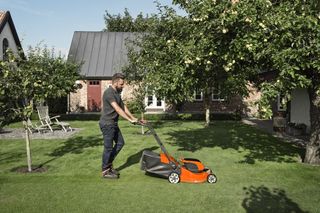Grass Cutting Step-by-Step Guide - How to Cut an Overgrown Lawn
Maintaining a well-groomed lawn can be challenging at the best of times, but it’s worth the effort. Overgrown grass is not only an eyesore to look at, but it also poses a risk for wildfires, pests, rodents, and snakes. After reading that, it may be tempting to hack it down to the ground. But, if you want your lawn to grow back thick and lush, then a slow and gentle approach is required.
In this step-by-step guide, we will give you detailed instructions and tips on how to effectively and safely cut an overgrown lawn. We will emphasise the importance of proper techniques, tools, and post-cutting maintenance — all with the aim of achieving a healthy and well-maintained lawn.
Step 1: Assess the Condition of Your Lawn
Assessing the condition of your lawn is an important step in understanding its needs and ensuring its overall health and beauty. By taking the time to evaluate your lawn, you can identify any issues or areas that require attention. Here are some steps to help you assess the condition of your lawn:
- Take a walk: Start by walking around your lawn and carefully observe the overall appearance. Look for any signs of stress, such as discolouration, thinning grass, or patches of bare soil. Note any areas that seem unhealthy or different from the rest of the lawn.
- Check for weeds: Look for any signs of weeds and invasive plants. Identify the types of weeds present and consider the extent of their growth. Weeds can compete with your grass for nutrients and sunlight, so it's important to address them accordingly.
- Examine the soil: Dig a small hole in a few locations across your lawn and examine the soil. Pay attention to its texture, moisture level, and the presence of any pests or insects. Healthy soil is crucial for a thriving lawn, so understanding its condition is essential.
- Test the pH: Conduct a soil pH test to determine the acidity or alkalinity of your soil. Most lawns thrive in slightly acidic to neutral pH levels. Testing the pH can help you identify if any adjustments, such as lime or sulphur applications, are needed to create the optimal growing environment for your grass.
- Consider water drainage: Observe how water drains in your lawn after rainfall or irrigation. Look for areas where water accumulates or forms puddles, as these could indicate drainage issues that need to be addressed.
These steps will give you a better understanding of the current state of your lawn so you can take appropriate action to maintain or improve its condition. Once you’ve addressed major issues, you’ll be ready to start thinking about when to give it a good mowing.
Step 2: Choose the Right Time
The best time to cut long grass varies depending on a few factors, like where you live and what type of grass you have. The best time to cut long grass is typically during spring, autumn or winter. Cutting long grass during hot summer days can damage it beyond repair.
If you have warm-season turf (like Buffalo grass), cut it to a height of no lower than 50mm. And for cool-season turf (like Perennial ryegrass), make sure the blade is no lower than 30mm. Ideally, you want sunny and warm days for the task. This not only makes the job more enjoyable for you, but it also helps prevent the establishment of bacteria and diseases on your lawn.
By ensuring that the grass is dry when you cut it, you minimise the risk and maintain a healthier lawn. For lawns that are particularly overgrown, it may be necessary to schedule multiple mowing sessions over the course of a month. This gradual approach allows for more effective and manageable results.
Step 3: Prepare Your Tools and Equipment
To ensure a smooth and efficient lawn care experience, it's essential to properly prepare your tools before making your first cut. Here are some steps to help you get ready:
- Fresh line for your grass trimmer: Before starting, make sure to add fresh trimmer line to your grass trimmer. This will ensure optimal cutting performance and prevent any interruptions during the trimming process.
- Sharpen mower and brushcutter blades: Take the time to sharpen the blades of your mower and brushcutter. This will result in cleaner and more precise cuts, reducing the strain on the motor and improving overall efficiency.
- Replace old fuel: It's important to use fresh fuel in your equipment. If you have any old fuel remaining, replace it with new fuel to ensure smooth operation and prevent any potential issues.
- Top-up oil: Check the oil level in your equipment and top it up if needed. Proper lubrication is crucial for the smooth running of your tools and helps to extend their lifespan.
- Annual servicing: It's wise to take your mowers and trimmers for an annual service at your local Husqvarna dealer or service centre. This will help ensure that your equipment is well-maintained, in optimal condition, and performing at its best.
Step 4: Making The First Cut
If your lawn has become unruly and the grass is taller than your knees, don't worry! We recommend using the Husqvarna 122C grass trimmer — the perfect tool for quickly and effortlessly reducing the height of the grass by 50%. Avoid using a lawn mower on long grass, as it can hinder the blades from spinning and potentially overheat the motor.
Long grass can obscure the view of the ground, making it difficult to see potential hazards. You definitely don't want to accidentally run over snakes, spiders, or nesting birds with a lawn mower! If your lawn has an abundance of weeds and shrubs in the grass, a brushcutter like the Husqvarna 129R can help you tackle them effectively. Remember, it is always worth taking the extra precaution to ensure your safety by wearing quality PPE whenever possible.
Once you've successfully reduced the grass to about 50% of its original height, allow it some time to recover and repair itself. This rest period is crucial for optimal regrowth. After approximately 2 to 4 days, use a grass trimmer to repeat the cutting process. During this second cut, you can safely reduce the grass height to approximately 6 inches.
Step 5: Time to Use a Lawn Mower
Approximately 8 days after your initial cut, it's time to bring out your lawn mower to finish the job. To ensure the best results, we recommend adjusting the height of your lawn mower so that the grass is cut down by an additional third.
If you’ve had enough of manual mowing and would rather leave it to a trusted robot mower, then now is the perfect opportunity to install an Automower®. Those of you who enjoy traditional lawn mowers should create overlapping passes to achieve a uniform and even finish.
By now, your grass should be around 4 inches tall. To maintain your desired height, we recommend repeating this process every 4 to 5 days. Remember to decrease the cutting height by 1/3 until you're satisfied with your lawn's height. To encourage straight blades of grass, try cutting in different directions each time. Once you've finished mowing, give your lawn a good soaking and let it rest.
Best Practices to Prevent Your Lawn From Becoming Overgrown
With its advanced features and innovative technology, a Husqvarna Automower® like the Automower® 310 Mark II is truly the ultimate lawn care companion. This robotic mower takes the hassle out of maintaining a beautiful lawn, allowing you to enjoy your outdoor spaces without the stress of constant upkeep. The Automower® operates on a preset schedule, quietly working day and night to keep your lawn at the perfect height all year round. Say goodbye to the tedious task of manual mowing and hello to a well-maintained lawn effortlessly.
Thanks to its intelligent sensors and boundary wires, the Automower® stays within the designated mowing area, avoiding obstacles and protecting your plants. This means you can trust it to take care of your lawn, even in complex landscapes or gardens with flower beds and trees. The Automower® is not only a time-saver but also an eco-friendly choice, as it operates on battery power and produces no direct emissions.
Post-Cutting Maintenance Tips for a Healthy Lawn
During periods of drought or decreased rainfall, it's important to give your lawn a thorough soaking every 7 to 10 days. Many people make the mistake of simply giving the surface a quick sprinkle of water, which doesn't get absorbed and ends up evaporating. By providing deep watering, you ensure that the moisture reaches the root system where it's needed most. This helps to keep your lawn healthy and prevents it from going to seed, giving it a prickly and unsightly appearance. A few other top tips include:
- Consider using organic fertilisers to nourish your lawn and avoid harmful chemicals.
- Use natural weed control solutions like vinegar or boiling water to avoid chemical herbicides.
- Mow your lawn in the early morning or early evening to avoid heat stress and maximise water absorption.
- Test your soil to determine its pH levels and any nutrient deficiencies, then adjust accordingly to maintain a healthy lawn.
- Install Automower® to take care of daily, weekly or monthly mowing for a carpet-like finish, day after day.
A Cut Above at Husqvarna
At Husqvarna, we're dedicated to providing the very best in lawn care equipment and support. Whether you're looking for an Automower® to simplify your lawn maintenance, or high-quality tools to help shape and maintain your garden, we've got you covered. Explore our full range of lawncare equipment online or visit your local Husqvarna dealer for more.










